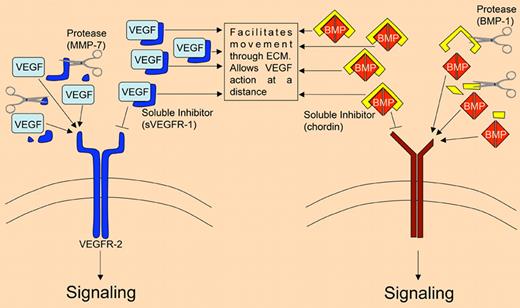In this issue of Blood, Ito and colleagues define a novel extracellular mode of action for the VEGF-A signaling cascade.
Vascular endothelial growth factor A (VEGF-A) is bound by an inhibitory factor and, on activation of matrix metalloproteinase (MMP), the inhibitory factor is cleaved and VEGF-A is available to signal. VEGF is a critical factor in many diverse developmental and disease processes, and the new mode of action discovered by Ito et al provides new understanding of this key pathway.1
VEGF is normally thought to signal by diffusion from its source to nearby cells expressing critical receptors. However, it has recently been shown that an endogenous form of VEGF-R2 exists as a secreted molecule and includes the VEGF binding extracellular domain. Here, Ito et al ask whether the binding of this factor is permanent or whether it can be released, freeing VEGF for signaling. Indeed, they show that MMP-7 is a secreted protease capable of clipping sVEGF-R2 and releasing an active VEGF protein.
This set of observations is highly reminiscent of the extracellular regulation of a different family that signals through tyrosine kinase receptors, the bone morphogenic protein family (BMPs). As summarized by O'Connor et al,2 a soluble protein such as chordin can bind and inhibit BMPs from signaling, as shown in the figure. However, a secreted protease called BMP-1 can readily bind and cleave chordin, releasing active BMPs.
VEGF extracellular signaling inhibition is similar to another tyrosine kinase pathway, BMP. Binding of the sVEGFR-1 inhibits VEGF action and allows movement through the extracellular matrix. VEGF is allowed to signal only after degradation of sVEGFR-1 by MMP-7 (left). This inhibition of signaling is similar to that seen in the BMP extracellular cascade (right).
VEGF extracellular signaling inhibition is similar to another tyrosine kinase pathway, BMP. Binding of the sVEGFR-1 inhibits VEGF action and allows movement through the extracellular matrix. VEGF is allowed to signal only after degradation of sVEGFR-1 by MMP-7 (left). This inhibition of signaling is similar to that seen in the BMP extracellular cascade (right).
What is most intriguing about the comparison between these otherwise seemingly divergent pathways is the known effect of such inhibitory complexes on BMP signaling. Such inhibition can have the counterintuitive function of activating BMP signaling at a distance by facilitating the factor's movement through the extracellular matrix. Work on BMPs also implicated regulation at the protease as a notable regulatory step in controlling this critical pathway.
What does this all mean for VEGF signaling gurus? First, measuring total VEGF is not sufficient to predict VEGF activity because some fraction will be bound to the inhibitor. Second, this model predicts scenarios where such secreted VEGF binding proteins can be both activators as well as repressors, depending on cellular and tissue context. Finally, this model suggests a new mode of regulation for this key signalingcomplex through the regulation of MMPs—at least in scenarios where MMPs are known to play a role.
Conflict-of-interest disclosure: The authors declare no competing financial interests. ■


This feature is available to Subscribers Only
Sign In or Create an Account Close Modal